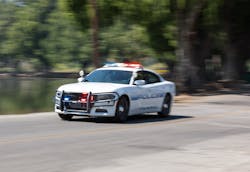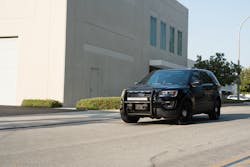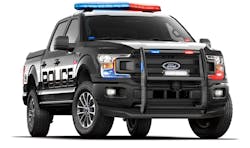Push bar, grille guard, push bumper, bull bar and brush guard. Although there are a number of names and some distinctions in style and function, most people recognize this beefy attachment on the front of a police vehicle. Their concept goes back to the 1800s when the first cowcatchers were attached to the front of trains to help prevent derailment due to obstacles such as free range cattle on the tracks. Patrol cars in the 1940s and 50s had solid front bumpers with built-in push capacity. In the 1960s, vehicle design changed and with it came the appearance of an aftermarket attachment. The push bar accomplishes its original intended use allowing officers to push things, including other vehicles and debris, out of the roadway. They reduce damage due to animal collisions, as well as push through brush when off-road. Wrap-style, or wrap-around, and PIT wings, which are a bolt-on addition, allow officers to minimize damage to their vehicle while performing a Precision Immobilization Technique (PIT) maneuver.
Though some concerns of push bars have arisen over the years, their usefulness is undisputed. What lies ahead for the equipment in the future? Innovation will be around the construction and design of the product — and perhaps a complete departure as vehicle technology continues to evolve.
Pinpointing the troubles of the past
Although the utility of push bumpers is undeniable, a number of negative opinions on the equipment still run rampant. The predominant concerns about push bars revolve around safety, both for the officer and the community. One concern is whether push bumpers negatively affect airbag deployment. David Hoel, national sales manager for Go Rhino, says this myth is debunked if you understand the technology. “All the manufacturers design to not affect the sensors that activate the airbag,” he explains.
Since this was one of the first concerns, manufacturers were quick to design push bars that did not affect this safety device. “We’ve learned throughout the years that the way that our push bumper is mounted has no interference,” says Miguel Alcantar, public safety product manager for Westin. “It is mounted directly to the frame so it allows the airbag to impact like a normal collision.”
A second concern was whether the rigid metal attachment would affect crumple zones designed to protect vehicle passengers. Again, manufacturers have developed designs to reduce this issue. “Manufacturers have looked at the mounting, at the brackets and make sure it’s supported,” Steve Somerville, president of Crown North America (Crown NA), explains. He states when manufacturers build the brackets and mounts, they make sure to be sensitive to the crash zone. Although, historically, some vehicles have come out of the factory upfitted with push bars, such as the Dodge Charger Pursuit, and therefore fully compliant with Federal Motor Vehicle Safety Standards (FMVSS) 208 (crashworthiness and airbag compatibility), most do not have a safety rating. Getting federal safety approval is difficult due to the diversity of the products. Tom Spence, senior engineer at Crown NA adds if OEs test and validate one push bar, it would validate all of them.
Hoel adds another deterrent to testing is that it would be expensive and a push bar only costs a couple hundred dollars.
Another concern is push bars are a damage multiplier, causing more severe accidents especially when colliding with a pedestrian. A 2012 study concluded they were more dangerous and many places around the world have restricted their use. Like most police equipment, the negatives have to be weighed with the benefits.
Addressing the benefits in sound and light
One of the biggest benefits to push bars is the ability to mount the siren in front of the vehicle and availability of more space to add lights to the front. “Instead of being just a piece of metal on the vehicle, they are putting in lighting that makes it safer,” Spence says. “You’re moving your front LEDs from behind the grille to the front. They are a lot more pronounced. You can move some of your side lighting and put it on the front. It provides awareness.”
The siren is no longer being tucked away, reducing muffle and increasing effectiveness. Attaching the speaker to the push bumper allows the noise to get out where it’s most useful. “It gets the noise out in front of the vehicle and you actually push the sound,” says Hoel. 123 decibels (dB) is optimal and moving the speaker out front gives maximum dB.
“When you put it behind the fascia, it’s putting material in front of the speakers,” Somerville adds, explaining how placement affects the sound. Although this is great for dB level, it can add challenges in many parts of the country. “If you put the speakers out front in certain climates, like snow, it gets exposed,” Somerville explains. “In a tropical climate, they get wet. When you put them behind the fascia, they are more protected. They are more sensitive out front.” Agencies must weigh the trade-offs to determine what best meets their department’s needs.
Is there a ‘right’ material?
As manufacturers and upfitters continue to innovate, one thing is clear — there’s some disagreement in what metal makes the best push bar material. “We use two materials across the industry,” explains Hoel. “One is aluminum. The other is steel. Steel is the big brother and aluminum is the little brother.” In Hoel’s opinion, steel is much better and handles impact better than aluminum. “Aluminum is used when people are concerned with rust,” he says. “They will use the aluminum to mount their lighting and speakers which is about one-third the weight of steel.”
Alcantar of Westin stands behind the big brother. “[Steel] is proven to take a hit and holds up better than aluminum,” he argues. “You don’t want to put something lighter on the front of something that is already made out of a steel frame. If you want to have something that does what it says it does — push and protect — then you want steel.” The company added a wider rubber strip, too, so it has a better push. “Our mounting is heavy duty. It is double coated so it won’t rust or corrode in the months that it has been on there, especially in the areas with snow and salt on the ground.”
Crown NA’s Spence stands by the little brother. “Aluminum is the best one going,” he states. “It takes the elements better than steel will.” He also mentions the benefit of weight, stating aluminum push bars are lighter in front of the axle. More weight in front of the axle can affect steering, which is never a good thing, especially at high speeds.
Recognizing a purist approach wasn’t the best approach, Spence explains their mounting, hardware and bracketry are steel, maximizing on the strengths of both materials.
Hoel takes this discussion a bit further, assessing the actual needs of the department. “Some departments have a no-push policy,” he explains. “They will use (the push bar) for speaker and lighting placement. That is when the aluminum comes into play.” Like many products, departments should assess what their policies are and what they plan to use the push bar for to determine which metal makes more sense.
Into the future
Although push bars might seem to be one of those products where there isn’t anything new about them, this isn’t entirely accurate. Areas of innovation will be around construction and design, including strength and stability of material and how you seat parts, explains Spence. “You are bringing together half a dozen parts,” he adds. “Lately, they are seating the cross bar into the vertical. It’s a better weld and design system.”
Companies are continuing to look at lighter material, continuing to optimize opportunity for lighting and decreasing installation time. “We’re making a stronger product than in the past,” Spence says. “In the past, if you push on it, it got all twisted. You could misshape it.”
Alcantar believes companies manufacturing aluminum will move into using steel. “More and more people are going to want to have something that does the job — which is to protect the vehicle — and has the ability to push something off the road,” he explains.
Hoel has a different vision for the future of push bars. “I think the push bumper used as an aggressive tool will probably go away with how the cars are changing electronically,” he explains. Instead of dangerous and high liability pursuits and PIT maneuvers, the future is using the car’s electronics through systems like OnStar to just slow the car down. Hoel described a recent incident in Phoenix, Ariz., where a brand new Chevy truck was stolen off the lot. OnStar was able to slow the vehicle down from the satellite, allowing officers to box it in and arrest the driver. “We have the technology available,” Hoel adds. No matter what the future holds, even if scientists one day create an electronic force field strong enough to replace push bars, one thing is certain — the sharp, utilitarian profile of patrol vehicles will not be the same.
About the Author
Michelle Perin has been a freelance writer since 2000. In Dec. 2010, she earned her Master’s degree in Criminology and Criminal Justice from Indiana State University.
Gamber-Johnson LLC Enters Push Bumper Market
Gamber-Johnson, known for docking stations and console boxes in the patrol car, is adding push bumpers to its product line, in addition to partitions, window guards, trunk trays and gun racks. The company will have both steel and aluminum push bumper options, says Nathan Grassl, product marketer with Gamber-Johnson. “We’ve always done the console boxes and docking stations, but we wanted to expand our portfolio and get out of the front seat, so to speak,” he says.

Michelle Perin
Michelle Perin has been a freelance writer since 2000. In December 2010, she earned her Master’s degree in Criminology and Criminal Justice from Indiana State University.





